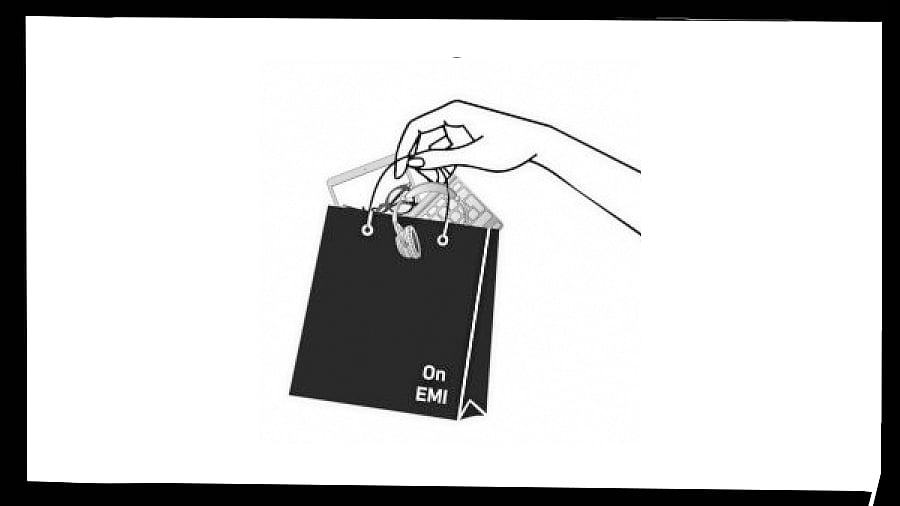
India’s households, long regarded as cautious savers, are quietly taking on record levels of debt. According to the Reserve Bank of India (RBI)’s Financial Stability Report, household debt in India is 42% of the GDP at the end of 2024, up from just 26% in 2015. Which means that in absolute terms, the total debt is nearly three times bigger. The average debt per individual has jumped 23% in just two years. This means the average debt per person is rising at twice the speed of national income. It has risen from Rs 3.9 lakh in 2023 to Rs 4.8 lakh by March 2025. About 55% of this borrowing comes from non-housing retail loans such as credit-card dues, personal loans, auto loans, and gold loans, while traditional home loans make up only about 29% of the total household debt. Thus, an increasing share of household borrowing is being used not to build assets but to make ends meet. The middle-class and lower-middle-class families who prided themselves on thrift and saving for children’s education, gold jewellery, or a small home are borrowing to spend on current consumption.
A rising debt-to-GDP ratio, especially if the borrowing is driven by consumption rather than productive investment, will weaken the foundation of India’s long-term sustained growth. India’s debt ratio is still much below other developed economies. In Australia and Canada, the household debt is more than 100% of the GDP. But unlike India, these countries have generous social security and old-age-assured income security, reducing their households’ need to have high savings. In the US, too, the ratio of household debt to GDP is 75%; it is 63% in China. The memory of the financial crisis caused by housing mortgages in the US and the Evergrande crash in China is, hopefully, not forgotten.
Compared to a potential bubble-like build-up, India’s household debt at 42% of the GDP looks manageable. But it has risen steadily for five years, substantially outpacing income growth. A study by the Bank for International Settlements spanning 54 countries found that while higher household debt initially boosts consumption and GDP, beyond a threshold of 60% of GDP, it begins to drag growth down, reducing long-run GDP by 0.1 percentage point for every additional point of debt. India’s ratio, though currently lower, is moving in that direction.
The problem is not borrowing per se, but its purpose. Loans for education, housing, or small businesses build future assets. But loans for consumption create no productive capacity. A growing number of households are using credit to pay for everyday expenses such as groceries, utility bills, school fees, or healthcare.
This is seen in the ballooning gold loans. RBI data shows that gold loan portfolios more than doubled between mid-2023 and mid-2025. The growth rate for gold loans was a whopping 122% in July 2025. The bulk of the gold loans from banks are of ticket size of less than Rs 2.5 lakh, for which the RBI has slackened the regulatory limits. The appraisal is lighter, and the loan-to-value ratio is allowed to be as high as 85%. But the RBI is aware of the build-up of bad loans in micro-finance and has tightened regulation there. During this same period, microfinance outstanding loans have dropped by 16.5%, indicating that some of the increase in gold loans is a substitution. It means that lower- and middle-income households who depended on MFIs or unsecured credit are turning to gold loans, which have also been fuelled by soaring gold prices. But a surge in gold loans only signals that households are liquidating last-resort savings to finance consumption or service other debts.
A cultural shift in credit
Two other phenomena cause concern. One is that rural wages have remained stagnant in inflation-adjusted terms. The cost of urban living is rising. Hence, debt has become a coping mechanism. The second is the declining financial savings of households. The net financial savings have declined from 11% of the GDP in FY2021 to 5% in FY2023. There has been a slight improvement in the past two years. The household savings pool has been the bedrock on which both the government’s fiscal needs and companies’ credit needs are financed. With declining savings, these will become costlier to finance.
Some of this also reflects a shift in credit culture. The aggregate savings rate is down from a peak of 36% to about 30% of the GDP. There are aspirations for higher living standards. Digital credit is easy to access, and there is perhaps a post-pandemic desire for instant gratification. Consumer loans have been outpacing bank
credit growth for the past five years. Credit card spending has increased 13 times in 13 years. Younger, salaried consumers are borrowing heavily against future income to sustain present lifestyles. At the same time, lower-income and rural households, facing stagnant earnings, are turning to gold and small personal loans to manage essential spending.
Credit expansion boosts demand and growth in consumer goods. But it makes households vulnerable to shocks from job loss, illness, or crop failure. It crowds out financial savings, making credit costlier. Beyond a point, it increases financial system stress. If left unchecked, it can erode the very resilience that once defined Indian households. Reversing the slide requires restoring the habit of financial savings, raising real incomes, and ensuring that borrowed money builds tomorrow’s assets, not just today’s consumption. It requires regulating aggressive consumer lending. It needs to encourage loans for education, homes, and MSMEs. India’s households, once the quiet financiers of both growth and government, must be restored to financial health, which can be achieved by returning to traditional values of caution and thrift rather than leaving them on the path to distress and debt.
(The writer is an economist; Syndicate: The Billion Press)
Disclaimer: The views expressed above are the author's own. They do not necessarily reflect the views of DH.